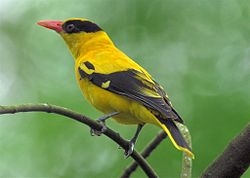Old World oriole
| Oriolidae | |
|---|---|
 |
|
| Black-naped oriole | |
| Scientific classification | |
| Kingdom: | Animalia |
| Phylum: | Chordata |
| Class: | Aves |
| Order: | Passeriformes |
| Suborder: | Passeri |
| Family: |
Oriolidae Vigors, 1825 |
| Genera | |
The Old World orioles (Oriolidae) are an Old World family of passerine birds.
The family Oriolidae comprises the figbirds in the genus Sphecotheres, and the Old World orioles in the genus Oriolus. Several other genera have been proposed to split up the genus Oriolus. For example, the African black-headed species are sometimes placed in the genus Baruffius. In 2011 the genus Turnagra was found to be placed within this family. The family is not related to the New World orioles, which are icterids, family Icteridae.
The orioles and figbirds are medium-sized passerines, around 20–30 cm in length, with the females only slightly smaller than the males. The beak is slightly curved and hooked, and, except in the figbirds, as long again as the head. The plumage of most species is bright and showy, although the females often have duller plumage than the males do. The plumage of many Australasian orioles mimics that of friarbirds (a genus of large honeyeaters), probably to reduce aggression against the smaller orioles.
Orioles are monogamous, breeding in territorial pairs (although the Australasian figbird, and possibly also the other figbirds, breed in loose colonies). Nesting sites may be chosen near aggressive species such as drongos, shrikes or friarbirds, which confer a degree of protection. The nest is a deep woven cup suspended like a hammock from a branch. They usually lay two or three eggs, but as many as six have been recorded.
The family is distributed across Africa, Europe, Asia, and Australia. The few temperate nesting species are migratory, and some tropical species also show seasonal movements.
Orioles are arboreal and tend to feed in the canopy. Many species are able to survive in open forests and woodlands, although a few are restricted to closed forest. They are opportunistic omnivores, with the main components of their diet being fruit, berries, arthropods, and nectar.
...
Wikipedia
